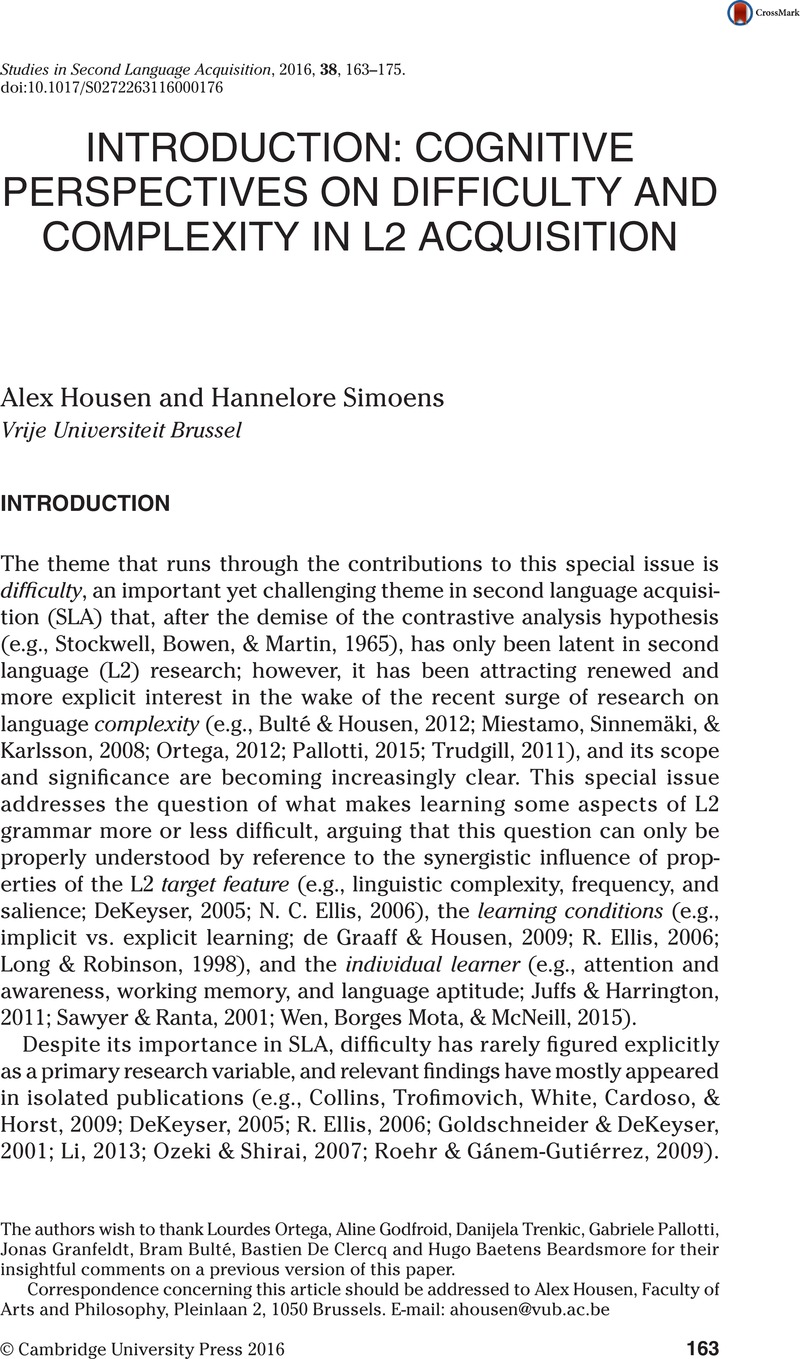Crossref Citations
This article has been cited by the following publications. This list is generated based on data provided by Crossref.
Cerezo, Luis
Caras, Allison
and
Leow, Ronald P.
2016.
THE EFFECTIVENESS OF GUIDED INDUCTION VERSUS DEDUCTIVE INSTRUCTION ON THE DEVELOPMENT OF COMPLEX SPANISHGUSTARSTRUCTURES.
Studies in Second Language Acquisition,
Vol. 38,
Issue. 2,
p.
265.
Wen, Zhisheng (Edward)
2016.
Phonological and executive working memory in L2 task-based speech planning and performance.
The Language Learning Journal,
Vol. 44,
Issue. 4,
p.
418.
Olthof, Marieke
2017.
Transparency in Norwegian and Icelandic: Language contact vs. language isolation.
Nordic Journal of Linguistics,
Vol. 40,
Issue. 1,
p.
73.
De Clercq, Bastien
and
Housen, Alex
2017.
A Cross‐Linguistic Perspective on Syntactic Complexity in L2 Development: Syntactic Elaboration and Diversity.
The Modern Language Journal,
Vol. 101,
Issue. 2,
p.
315.
Ammar, Ahlem
and
Hassan, Rania Mohamed
2018.
Talking It Through: Collaborative Dialogue and Second Language Learning.
Language Learning,
Vol. 68,
Issue. 1,
p.
46.
Chan, Mable
2018.
Processing instruction in helping map forms and meaning in second language acquisition of English simple past.
The Journal of Educational Research,
Vol. 111,
Issue. 6,
p.
720.
Nyqvist, Eeva-Liisa
2018.
Definiteness in written Swedish by Finnish-speaking immersion pupils
at the end of immersion.
Journal of Immersion and Content-Based Language Education,
Vol. 6,
Issue. 1,
p.
57.
Denhovska, Nadiia
Serratrice, Ludovica
and
Payne, John
2018.
Frequency and working memory effects in incidental learning of a complex agreement pattern.
Lingua,
Vol. 207,
Issue. ,
p.
49.
Shiu, Li-Ju
Yalçın, Şebnem
and
Spada, Nina
2018.
Exploring second language learners’ grammaticality judgment performance in relation to task design features.
System,
Vol. 72,
Issue. ,
p.
215.
Nyqvist, Eeva-Liisa
2018.
Mastering complex Swedish NPs: A comparison of non-immersion pupils and
immersion L1 Finnish pupils.
Journal of the European Second Language Association,
Vol. 2,
Issue. 1,
p.
14.
Jiang, Jingyang
Bi, Peng
and
Liu, Haitao
2019.
Syntactic complexity development in the writings of EFL learners: Insights from a dependency syntactically-annotated corpus.
Journal of Second Language Writing,
Vol. 46,
Issue. ,
p.
100666.
Pallotti, Gabriele
2019.
An Approach to Assessing the Linguistic Difficulty of Tasks.
Journal of the European Second Language Association,
Vol. 3,
Issue. 1,
p.
58.
Housen, Alex
De Clercq, Bastien
Kuiken, Folkert
and
Vedder, Ineke
2019.
Multiple approaches to complexity in second language research.
Second Language Research,
Vol. 35,
Issue. 1,
p.
3.
SUZUKI, YUICHI
NAKATA, TATSUYA
and
DEKEYSER, ROBERT
2019.
The Desirable Difficulty Framework as a Theoretical Foundation for Optimizing and Researching Second Language Practice.
The Modern Language Journal,
Vol. 103,
Issue. 3,
p.
713.
Brezina, Vaclav
and
Pallotti, Gabriele
2019.
Morphological complexity in written L2 texts.
Second Language Research,
Vol. 35,
Issue. 1,
p.
99.
Gilabert, Roger
and
Castellví, Joan
2019.
The Cambridge Handbook of Language Learning.
p.
527.
Pallotti, Gabriele
2019.
Assessing Tasks: The Case of Interactional Difficulty.
Applied Linguistics,
Vol. 40,
Issue. 1,
p.
176.
Baten, Kristof
and
Cornillie, Frederik
2019.
Elicited imitation as a window into developmental stages.
Journal of the European Second Language Association,
Vol. 3,
Issue. 1,
p.
23.
Xu, Yiran
2019.
Changes in interlanguage complexity during study abroad: A meta-analysis.
System,
Vol. 80,
Issue. ,
p.
199.
Larsson, Tove
and
Kaatari, Henrik
2020.
Syntactic complexity across registers: Investigating (in)formality in second-language writing.
Journal of English for Academic Purposes,
Vol. 45,
Issue. ,
p.
100850.





